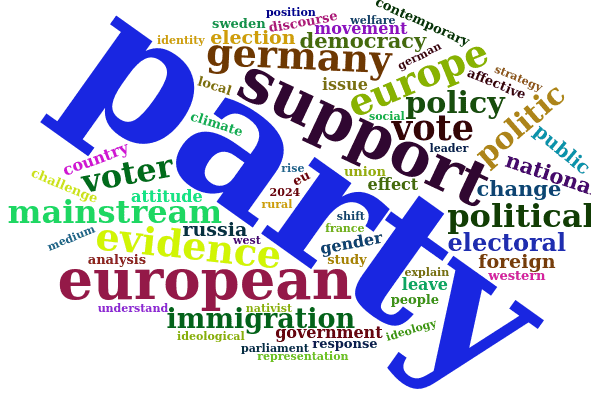Life is full of unforeseen, yet entirely predictable obstacles: over-committing, over-optimism, and yes, occasionally, over-indulgence. As a result, this year’s spring edition of the Eclectic, Erratic Bibliography on the Extreme Right (in (Western) Europe)™ is late, but here it comes. With 180 new titles, this is the second-biggest update ever, which just goes to show that the field, like its subject, keeps growing.
Click on this link to browse or download the latest full version of the bibliography in a format (BibTeX) that most reference managers will import. For long-time user of the bibliography, there is also an incremental update that contains just the titles that have been added since April 2024.
When and where was this new research on the radical right published?
Roughly half of the new stuff was published in 2024, while about a quarter of it was only published in 2025, i.e. during the last four months. This is in line with what we saw last year and, like last year, a second clear departure from the long-term trend. The field is expanding rapidly, and this is reflected in the data.
The final quarter is made up by publications that I have missed in previous years — most of them still fairly current, but also two from 2010 (!): Chryssogelos’ article on the Radical Right’s cosy relationship with Russia and Peter Davies excellent review of the Front National/Rassemblement National’s Catholic roots.
| Publication year | n |
|---|---|
| 2024 | 88 |
| 2025 | 42 |
| 2023 | 18 |
| 2021 | 11 |
| 2020 | 4 |
| 2018 | 4 |
| 2022 | 3 |
| 2019 | 2 |
| 2010 | 2 |
| 2017 | 1 |
166 of the 180 new entries are journal articles. Government and Opposition has lost its top spot to long-run champions West European Politics, Party Politics and European Journal of Political Research. European Political Science Review, which had two excellent years near the top, has dropped ten places. Go figure.
| Journal | n |
|---|---|
| West European Politics | 12 |
| Party Politics | 10 |
| European Journal of Political Research | 8 |
| British Journal of Political Science | 7 |
| Government and Opposition | 6 |
| Political Studies | 6 |
| Comparative Political Studies | 5 |
| Electoral Studies | 5 |
| German Politics | 5 |
| Journal of European Public Policy | 5 |
| American Political Science Review | 4 |
| European Politics and Society | 4 |
| Political Behavior | 4 |
| Comparative European Politics | 3 |
| European Political Science Review | 3 |
| International Sociology | 3 |
| Journal of Contemporary European Studies | 3 |
| Journal of Elections, Public Opinion and Parties | 3 |
| Perspectives on Politics | 3 |
| Political Science Research and Methods | 3 |
| Scandinavian Political Studies | 3 |
| South European Society and Politics | 3 |
| Acta Politica | 2 |
Perhaps the most interesting development is that the British Journal of Political Science, one of the discipline’s top general journals, sits in fourth place with seven articles in this edition of the bibliography. This is a third of the total number of BJPS articles in the bibliography (20). Make of that what you want.
What are the new topics in radical right research?
Like in past years, I have made word cloud (yes, I know) from the titles and abstracts. “party” is just as dominant as in previous years. So are “Europe/European”. “Support” is even more prominent than last year, and so is “Germany”. Sigh. Conversely, “Covid” and the pandemic have disappeared now.
Because everyone is now using LLMs (aka the plagiarism machine) to analyse text, I gave it a shot, uploaded the update to perplexity, and asked it to identify the most important themes. The list it came up with is entirely plausible:
1) Economic Insecurity and Radical Right Support
Multiple studies link economic anxieties — such as rising rents, labour market changes, and regional economic decline — to support for radical right parties. For instance Abou-Chadi, Cohen, and Kurer (2024) show that rental market volatility in Germany correlates with increased radical right voting among lower-income urban residents. Three articles discuss the role of emigration, which seems to be linked to democratic erosion and rising nativism.
2) Cultural Backlash and Identity Politics
This never gets old, no?
3) Leadership and Party Strategy
Older folks may remember the 1990s obsession with allegedly charismatic leaders. Thankfully, this is over, but there seems to be a renewed interest in how supply-side factors including the perceived traits of radical right may influence voter preferences. Other studies examine how parties use rhetoric to appeal to specific demographics.
4) Subnational Variation
I have a long-standing interest in subnational factors linked to radical right success, so I’m happy to see that this mini-trend is still going strong.
Who wrote this stuff?
While most authors have contributed just one or two works to the new release, a dirty dozen (many of them household names) stand out for their notably higher level of activity.
| Author | Titles |
|---|---|
| Duncan McDonnell | 7 |
| Annika Werner | 4 |
| Mattia Zulianello | 4 |
| Andrea L. P. Pirro | 3 |
| Gilles Ivaldi | 3 |
| Kai Arzheimer | 3 |
| Luca Carrieri | 3 |
| Manès Weisskircher | 3 |
| Natasza Styczyńska | 3 |
| Philip Rathgeb | 3 |
| Reinhard Heinisch | 3 |
| Sara B. Hobolt | 3 |
However, these numbers fluctuate quite a bit from year to year, not least because I sometimes come across an edited volume or a collection of articles a year or two after which it was published. Which brings me to a more general point: If you are aware of research that would be a valuable addition to this bibliography, I would be very interested to hear from you. Please feel free to suggest your own work as well-self-nominations are most welcome.
(Assumed) gender of radical right researchers
Because people do sometimes not use initials consistently (and because I am a lousy programmer) the figure may not be completely accurate, but there seem to be 291 unique authors in this update. Like in previous years, I have tried to algorithmically infer their gender, which is a notoriously messy business, particularly for non-European names.
201 names are classified as male, and 90 as female, which amounts to a ratio that is even worse than in the two previous years (34 and 37 per cent). This does not account for the number of publications someone is involved in, but either way, the overall picture is not good. But at least the perennial Michael seems to be gone.
Show us the latest titles in radical right research
Here is a full list of all that is new in the bibliography. Click here to download/import these new titles into your reference management software.






Hi Kai, you can add this to the bibliography (from 2024):
http://www.amazon.com/Political-En...
Bridgy Response